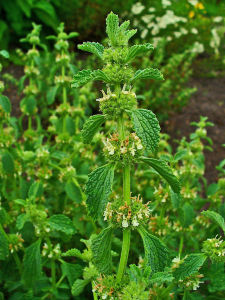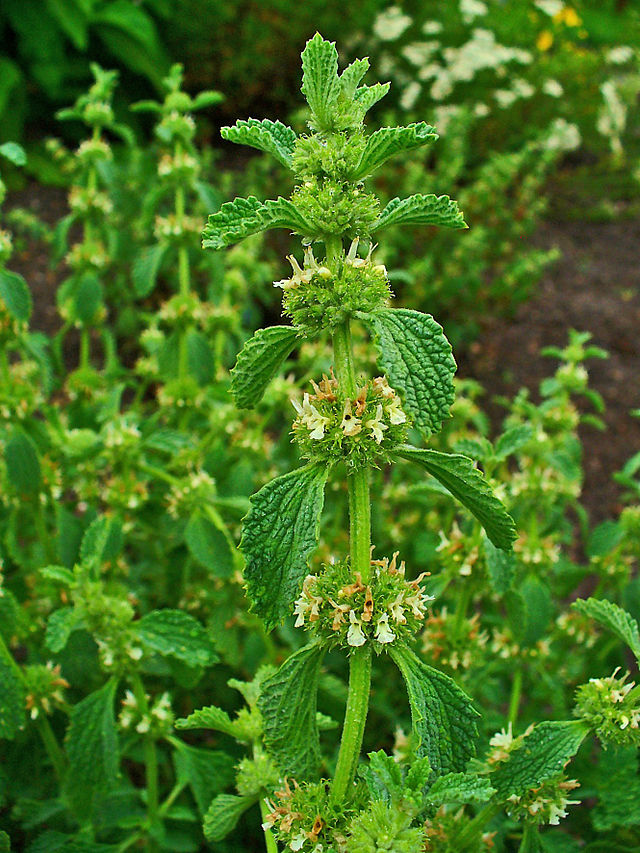 Our ancestors used herbs to treat and cure many ailments. More and more, modern science is validating their knowledge. White horehound, which had many medicinal uses in the past and remains popular as cough drops, has been found to be effective at clearing out lungs and stopping coughs.
Our ancestors used herbs to treat and cure many ailments. More and more, modern science is validating their knowledge. White horehound, which had many medicinal uses in the past and remains popular as cough drops, has been found to be effective at clearing out lungs and stopping coughs.
There are three types of horehound: Water Horehound (Lycopus americanus) which is related to the bugleweed, Black (Stinking) Horehound (Ballota nigra) and White Horehound (Marrubium vulgare), Both black horehound and white horehound are in the mint family. Black horehound not only is not medicinal, it is toxic in large doses and should be avoided.
White horehound is native to all of Europe, Asia and the northern part of Africa. It was transported to North America by the European colonists who brought it over with other medicinal herbs for their gardens. It has now naturalized throughout North America. It is perennial in zones 3 through 10. Like mints, its stems do not branch. Rather, the wrinkled leaves, covered with white hairs giving it its name, grow around the stem. It grows 18 to 24 inches tall. White horehound requires full sun and prefers poor, dry, sandy soils. It does well in a xeriscape. Bloom time is from June to September.
Propagation is by seed, cuttings or division. Division should be done in the spring. Cuttings should be taken in the late summer. Growing from seed is easy. The seed can be direct sown in your garden in either the spring or the fall (for germination the following spring). If you want to start your seeds indoors, you get better germination if you cold stratify your seeds. To cold stratify, sow your seeds and then place the container in a plastic bag, then put the whole thing in your refrigerator for about a month. Keep the soil moist. Don’t let it dry out. You can plant your seedlings in your garden after your last frost.
When not helped along by gardeners, white horehound uses animals to disperse its seeds. Each seed has a small “hook” on it which snags the fur of passing animals, hitching a ride to a new location. The seeds get “planted” when the animal brushes against something or scratches itself, loosening the seeds from its fur.
White horehound has a bitter smell when fresh. The odor diminishes as it dries but the taste remains bitter. White horehound is often mistakenly identified as one of the bitter herbs eaten at Passover. Modern research has revealed that it is not one of the bitter herbs referenced in the Bible. To make white horehound palatable for use as a remedy, add sugar or honey to it. The familiar horehound cough drops use brown sugar as a sweetener which gives them their brown color.
So the next time you are stuffy and coughing, grab some horehound cough drops for some old-fashioned relief.


12 Comments on “White Horehound”
Hi! I purchased herbs, horehound and spearmint, from the spring sale at Rutgers Gardens. After transplanting them into pots they seem to have shriveled up and the plants are all dried out. Is there any way to save them? I’m not sure what happened. The spearmint was doing okay and then looked rather dead. Please advise. Is there somewhere to obtain another horehound plant if this one won’t survive? Thanks.
Ingrid, it sounds like the plants did not get enough water. If you want to grow herbs in containers, you need to water frequently because the soil dries out very quickly. I water my containers every day. I will check the greenhouse and see if there are any horehound plants left.
Thanks for the reply. If you do have some still, please let me know. I think maybe they would do better planted in the ground.
Can you recommend a recipe for horehound cough drops?
Try this recipe: https://www.motherearthliving.com/health-and-wellness/horehound-cough-drops-zmrz12fmzwar
I have cuttings I got from someone of horehound wormwood and pineapple sage… We cut on an angle stripped the bottom leaves and placed in cups of water at our kitchen table… All 3 see to be alive for now but wilt on and off and have tips that seem mushy .
. Can I revive them… I was thinking of recutting the mushed tips dipping in a rooting hormone and planting in small pots rather than water… Of the 3 my horehound is doing the best the wormwood and pineapple sage seem rather touchy and droopy… I don’t think I can get more cuttings
Hi Heather, one of the first things I learned in the Master Gardener course was to never root anything in water because roots that grow in water are very weak because they have nothing to push against. What happens when you transplant cuttings rooted in water is that that some of the roots break and the rest are too weak to push throught the soil to grow. This is why so many cuttings rooted in water die.
In this case, all of the cuttings you have taken are from drought tolerant plants which means that they like to be very, very dry and cannot handle a lot of water. Too much water will kill them. I would recommend that you remove the cuttings from the water which is drowning them and put them in soil as soon as possible.
Please let me know if this works for you.
I have changed out their waters to keep it clean and have had them for a week so they are struggling but not yet dead surely that’s something 🙂
I have a white horehound plant. I tries rooting cuttings but no luck so far. The plant keeps coming back but this year no flowers or seeds. We had that awful poison snow Texas freeze and I really thought the plant was gone but it came back up just no flowers or seeds this yr. Help? As well cuttings…straight in ground or in water, water isn’t working??? I guess help with pulling leaves and making syrup, cook while they’re green or dry first? Thank you.
It’s probably flowering but you don’t recognize them as flowers. The round “balls” on the stems are the flowers. The seeds are also very small and hard to see. White horehound readily self-sows so I wouldn’t be surprised if some of the plants you are seeing are from seeds.
You don’t have to worry about freezes in Texas. White horehound is hardy through zone 3 where winter temperatures go as low as 30 to 40 degrees below zero.
These plants are propagated by stem cuttings which is why your root cuttings keep failing. Try taking stem cuttings in late summer and see if you have better luck. Always root your cuttings in soil. Cuttings rooted in water develop roots that are too weak to grow in soil so they almost all die when transplanted into your garden.
White horehound leaves are used fresh to make syrups. See this link: https://www.motherearthliving.com/health-and-wellness/horehound-cough-drops-zmrz12fmzwar. Step one tells you how to prepare a white horehound syrup.
I transplanted 3 large White Horehound plants that were growing in a field. They all got watered, not soaked. They’re all wilted after 1 day. Is that normal, will they come back? I got most of their roots.
Yes, it’s known as “transplant shock.” Keep the soil moist and they should bounce back after a few days.